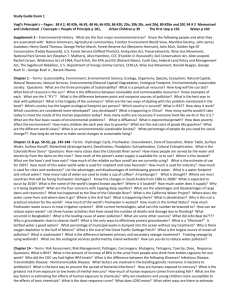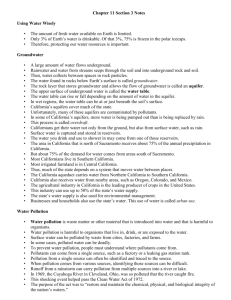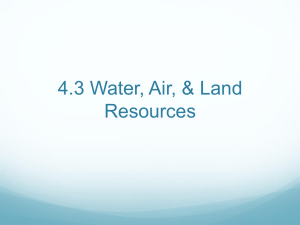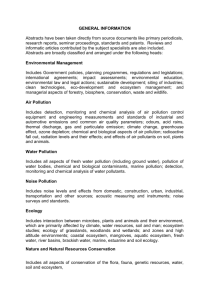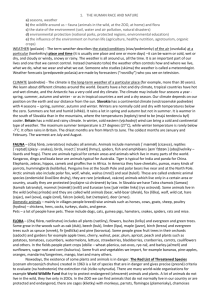Vocabulary List
advertisement
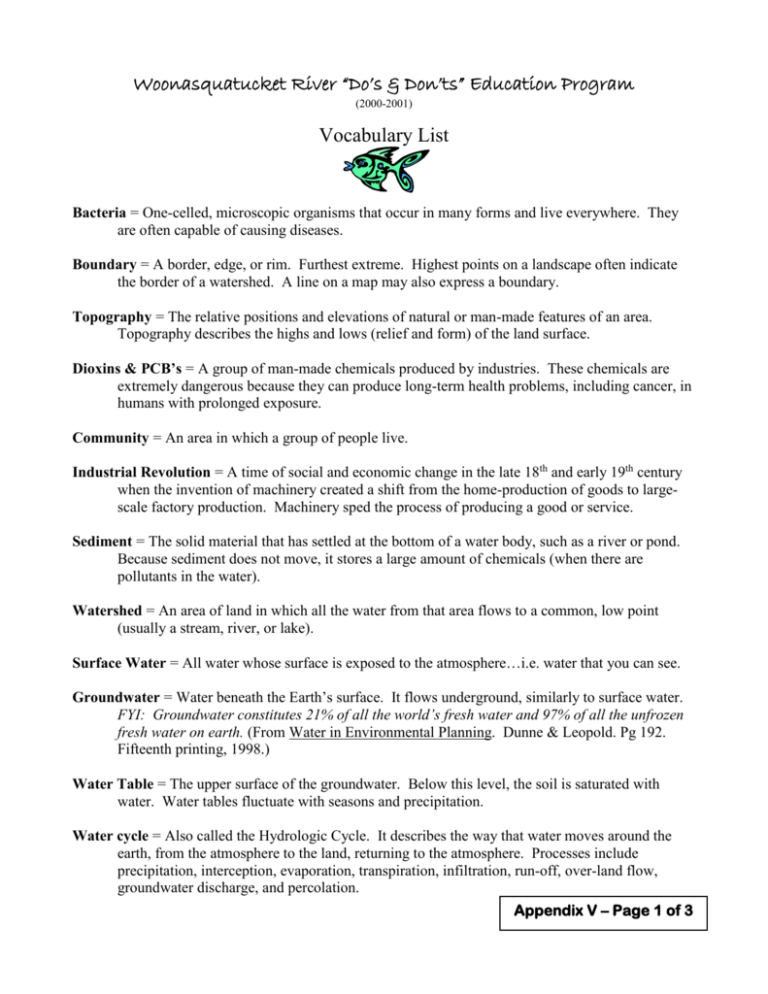
Woonasquatucket River “Do’s & Don’ts” Education Program (2000-2001) Vocabulary List Bacteria = One-celled, microscopic organisms that occur in many forms and live everywhere. They are often capable of causing diseases. Boundary = A border, edge, or rim. Furthest extreme. Highest points on a landscape often indicate the border of a watershed. A line on a map may also express a boundary. Topography = The relative positions and elevations of natural or man-made features of an area. Topography describes the highs and lows (relief and form) of the land surface. Dioxins & PCB’s = A group of man-made chemicals produced by industries. These chemicals are extremely dangerous because they can produce long-term health problems, including cancer, in humans with prolonged exposure. Community = An area in which a group of people live. Industrial Revolution = A time of social and economic change in the late 18th and early 19th century when the invention of machinery created a shift from the home-production of goods to largescale factory production. Machinery sped the process of producing a good or service. Sediment = The solid material that has settled at the bottom of a water body, such as a river or pond. Because sediment does not move, it stores a large amount of chemicals (when there are pollutants in the water). Watershed = An area of land in which all the water from that area flows to a common, low point (usually a stream, river, or lake). Surface Water = All water whose surface is exposed to the atmosphere…i.e. water that you can see. Groundwater = Water beneath the Earth’s surface. It flows underground, similarly to surface water. FYI: Groundwater constitutes 21% of all the world’s fresh water and 97% of all the unfrozen fresh water on earth. (From Water in Environmental Planning. Dunne & Leopold. Pg 192. Fifteenth printing, 1998.) Water Table = The upper surface of the groundwater. Below this level, the soil is saturated with water. Water tables fluctuate with seasons and precipitation. Water cycle = Also called the Hydrologic Cycle. It describes the way that water moves around the earth, from the atmosphere to the land, returning to the atmosphere. Processes include precipitation, interception, evaporation, transpiration, infiltration, run-off, over-land flow, groundwater discharge, and percolation. Appendix V – Page 1 of 3 Dissolve = To cause to pass into solution. When solids breakdown and become part of a liquid. Sewage = Liquid and solid waste material that is carried off with water in sewers and drains…it comes from toilets, sinks, washing machines, dish washers, etc. Pollution = Contamination of water, air, or soil by the discharge of harmful substances. The verb, POLLUTE, means to make unfit for, or harmful to living things, especially by the addition of waste matter. Point Sources of Pollution = A stationary pollution source, such as a smoke stack or discharge pipe. These are places that you can point to and say with confidence that that single source is creating pollution. Non-point Sources of Pollution = Pollution in which the source is not easily identifiable. Pollution may be coming from a variety of places, in small amounts, but when they combine, they create a significant source of pollution. Sources for Non-Point Source Pollution include: Soil erosion, Storm-water runoff, Household & automotive care, Construction sites, Agriculture, The food chain Soil Erosion = The detachment and movement of soil from the land surface due to wind or water. Storm-water Runoff = Rainwater flowing over paved or unpaved surfaces; picking up road salt, loose soil, lawn and garden chemicals, and animal wastes as it travels via the street to storm drains to nearby rivers, lakes and estuaries. Household and Automotive Care = Oil, grease, gasoline, paints and other household chemicals that are carelessly dumped onto streets and into storm drains, which ultimately end up finding their way into surface waters. These pollutants harm aquatic life and degrade human drinking water sources. Construction = Tons of soil, chemicals and trash wash from construction sites get washed into streams and storm drains. Frequently, aquatic habitats & recreational areas, streams, lakes, rivers and bays are blanketed with layers of unproductive mud. The Food Chain = The natural cycle of bigger animals eating smaller animals, which eat smaller animals and so forth. Pollutants that reach water can accumulate through the food chain, harming aquatic life and terrestrial life. In sever cases of water contamination, human consumption of fish may be banned in order to protect public health. Agriculture = Excess fertilizers & pesticides can drain into streams, rivers, lakes and bays, which will cause abnormally increased growth of algae and underwater weeds. By accumulating through the food chain, pesticides can have long-term effects on wildlife and human health. Appendix V – Page 2 of 3 Land Use = Description of how or what the land is used for, i.e. crops, forest, residential, livestock. Steward of the Land = Title given to people who manage and care for their environment. These people are concerned with the condition of the earth for the next generation, other people, and other living things. Recycling = A resource recovery method involving the collection and treatment of a waste product for use as a raw material when manufacturing the same or similar products. An example is ground glass being used to make new glass, or recycled oil used to make asphalt for paving roads. Natural Resource = A material source of wealth, such as timber, fresh water, or a mineral deposit. Some natural resources are renewable, while others have a limited supply and therefore need to be utilized wisely. Appendix V – Page 3 of 3

